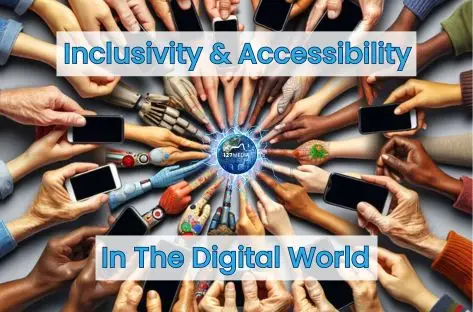Inclusivity and Accessibility were on the agenda of an online summit I attended recently on Community Engagement, in my role as a town councillor, hosted by the SLCC.
One presentation that particularly resonated with me was “Nothing About Us, Nothing Without Us!”
This insightful talk was put together by Dr Tanvir Bush from Bath Spa University and Sharon Thomas from Corsham Town Council, the latter of whom delivered the presentation, is also deaf.
The presentation delved into engaging our Deaf and Disabled communities for transformative inclusion and inspired by this session, I decided to share these insights on the critical importance of inclusivity and accessibility in the online world.
Recent statistics are eye-opening: approximately 24% of the UK population is disabled, yet many face barriers in society, significantly impacting employment and economic activity.
Shockingly, 75% of the companies in the FTSE 100 Index on the London Stock Exchange fail to meet basic web accessibility standards. This oversight results in a staggering potential revenue loss of over £118 million.
This article aims to shed light on the significance of inclusivity and accessibility in our digital interactions, whether through social media, websites, or the broader digital landscape.
By understanding and implementing these principles, we not only foster a more inclusive society but also unlock substantial financial benefits.
Let’s explore how we can make our digital spaces more welcoming and accessible to everyone.

Understanding the Importance
In the digital age, inclusivity and accessibility are not just buzzwords or ethical considerations; they are essential components of any effective online presence.
They ensure that digital content is accessible to all individuals, regardless of their physical abilities or socio-cultural backgrounds.
This approach is vital for social media, websites, and the broader digital estate.
Inclusivity: Beyond Borders and Boundaries
Inclusivity in the online world means creating content that resonates with a diverse audience.
It’s about understanding and reflecting on the rich tapestry of human experiences in your digital outreach. This goes beyond mere translation into different languages.
It involves tailoring content to be culturally relevant, sensitive, and engaging for various groups.
For social media, this means crafting posts and interactions that acknowledge and celebrate diversity. It’s about creating a community where every voice is heard and respected.
Businesses can foster inclusivity by highlighting stories from different communities, using diverse representations in their imagery, and engaging in conversations that matter to various groups.
Accessibility: Ensuring Everyone Can Engage
Accessibility focuses on making digital content usable for everyone, including people with disabilities.
This is crucial because around 15% of the world’s population experiences some form of disability.
Inaccessible websites or social media platforms can inadvertently exclude a significant portion of the audience.

Key accessibility considerations include:
- Visual Accessibility: Use alternative text for images on social media and websites. This helps screen readers describe images to visually impaired users. Ensure sufficient contrast between text and background colours for better readability.
- Auditory Accessibility: Provide captions or transcripts for video content. This not only aids individuals with hearing impairments but also benefits users who prefer reading over listening.
- Navigational Accessibility: Ensure your website can be navigated using a keyboard alone, catering to users who cannot use a mouse. Simple, intuitive navigation aids everyone, not just people with disabilities.
- Understandable Content: Use plain language to make content easily understandable. Avoid jargon and complex sentences, especially when conveying important information.
Impact on Social Media and Digital Platforms
Inclusivity and accessibility greatly influence how users interact with digital platforms. An inclusive social media strategy can significantly broaden your audience, leading to increased engagement and loyalty.
Accessible websites not only comply with legal standards but also enhance user experience, potentially reducing bounce rates and improving SEO rankings.
Tips for Business Owners
- Regular Audits: Conduct regular audits of your digital content to identify areas where inclusivity and accessibility can be improved.
- Diverse Representation: In imagery and narratives, ensure representation of various ethnicities, ages, abilities, and genders. This reflects a real-world demographic and fosters a sense of belonging among users.
- User Feedback: Encourage and pay attention to feedback from your audience regarding inclusivity and accessibility. They can provide invaluable insights into their experiences.
- Employee Training: Educate your team about the importance of inclusivity and accessibility. A well-informed team can create more empathetic and effective digital content.
- Partnerships: Collaborate with organisations or influencers who advocate for inclusivity and accessibility. This not only enhances your understanding but also demonstrates your commitment to these values.
Conclusion
Inclusivity and accessibility are not just ethical imperatives; they are strategic business decisions.
By embracing these principles, businesses can create a more engaging, welcoming, and effective online presence. In the process, they contribute to a more equitable and accessible digital world for everyone.
If you’d like to know more about how to ensure your online estate is inclusive and accessible, call me on +44 01704 332127, I’d be happy to help.


